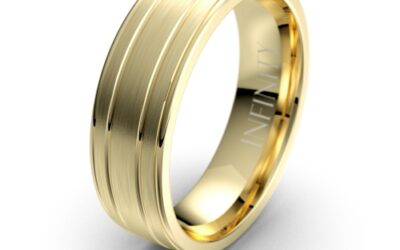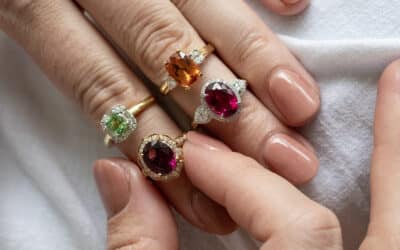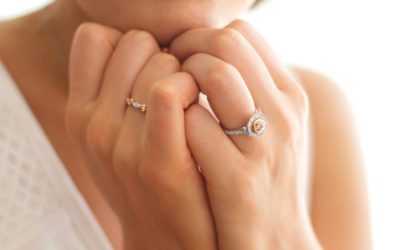Engagement ring global statistics
- The wedding ring market (which includes both engagement rings and wedding bands) was evaluated at $66 billion in 2018 and is expected to grow up to $107 billion by the end of 2027 (Apviz)
- The United States has the highest global consumer demand for diamond jewellery at 52% (Apviz)
- China, Japan, India and the Gulf represent 26% of the global consumer demand for diamond jewellery (Apviz)
- Australia is part of the rest of the world that collectively makes up 22% of the global consumer demand for jewellery (Apviz)
- The US also spends the most on diamond engagement rings, as their average spend is $6000 (Apviz)
- 33% of engagement ring buyers look for their ideal choice online (Apviz)
- 11% of engagement ring buyers used social media to contact retailers (Apviz)
Engagement ring statistics Australia
The following statistics were procured from a survey that was featured in an article by Refinery29, as well as VogueBallroom.
- The average amount spent on an engagement ring in 2019 was $5,297.50 (Refinery29)
- Those with a median income of around $67K spent $5,800 on an engagement ring on average (Refinery29)
- Those in the $177,000+ wage bracket spent an average of $15,600 on an engagement ring (Refinery29)
- In 2020, Moissanite was chosen by 26% of individuals as an alternative to the standard diamond engagement ring (VogueBallroom)
- Approximately 66% of all engagement rings featured a centre stone that was between ½ a carat and 1 and ½ carats (VogueBallroom)
- 43% of engagement rings feature a round cut centre stone (VogueBallroom)
- 48% of engagement rings featured a white gold setting (VogueBallroom)
- 16% of engagement rings featured a yellow gold setting (VogueBallroom)
- 13% of engagement rings featured a rose gold setting (VogueBallroom)
- 82% of people buying engagement rings did so with a specific amount of money in mind (VogueBallroom)
- About 66% of ring consumers were able to stay below their set spending limit (VogueBallroom)
- 91% of proposers purchased the ring themselves (VogueBallroom)
Engagement ring statistics in the US
The following statistics were taken from a market data report from 2023:
- 58% of engagement rings purchased are round diamonds (Gitnux)
- 70% of engagement ring shoppers prioritise certification and grading reports (Gitnux)
- About 75% of American brides wear a traditional gold and diamond engagement ring (Gitnux)
- 97% of brides are happy with their engagement ring (Gitnux)
- 3% of brides wish they had more involvement in the selection process (Gitnux)
- The most popular diamond carat weight for engagement rings is between 1 and 2 carats (Gitnux)
- 69% of brides prefer a traditional diamond as the main stone in their engagement ring (Gitnux)
- About 30% of couples shop for an engagement ring together (Gitnux)
- 66% of recipients are open to receiving a pre-owned or heirloom diamond engagement ring (Gitnux)
- December is the most popular month to buy an engagement ring (Gitnux)
- The average cost of an engagement ring in the US is $5,900 (Gitnux)
- 85% of brides receive a diamond engagement ring (Gitnux)
The following statistics were taken from a survey in 2022 that involved 2,432 recently engaged people.
Purchasing the ring
- 35.1% of men surprised their spouse with the engagement ring (Ringspo)
- 29.6% of couples chose the engagement ring together, but the man purchased the ring on their own (Ringspo)
- 25.9% of couples discussed the ring beforehand, then the man both chose and purchased the ring on his own (Ringspo)
- 9.4% of couples bought the ring together (Ringspo)
Visiting retailers
- 28.4% visited only 1 jewellery retailer before purchasing the ring (Ringspo)
- 42.6% visited 2-4 jewellery retailers before purchasing the ring (Ringspo)
- 21.3% visited 5-7 jewellery retailers before purchasing the ring (Ringspo)
- 4% visited 8-10 jewellery retailers before purchasing the ring (Ringspo)
- 3.7% visited 11+ jewellery retailers before purchasing the ring (Ringspo)
Types of retailers
- 31.2% purchased their engagement ring from a chain jeweller (Ringspo)
- 27.8% purchased their engagement ring from an independent jeweller (Ringspo)
- 11% purchased their engagement ring online (Ringspo)
- 7.8% purchased their engagement ring from a luxury jeweller (Ringspo)
- 5.8% purchased their engagement ring from a vintage store (Ringspo)
- 5.3% purchased their engagement ring from a department store (Ringspo)
- 5.2% purchased their engagement ring through miscellaneous means (Ringspo)
- 4.6% purchased their engagement ring from a big box store (Ringspo)
- 1.3% purchased their engagement ring from a wholesaler (Ringspo)
Engagement ring budgets
- 0.9% followed the three months salary rule (Ringspo)
- 33.1% used the three months salary rule as a guideline (Ringspo)
- 66% ignored the three months salary rule (Ringspo)
Average engagement ring cost 2022
- 19% spent less than $1000 on their engagement ring (Ringspo)
- 21% spent between $1000 and $1999 on their engagement ring (Ringspo)
- 11% spent between $2000 and $2999 on their engagement ring (Ringspo)
- 18% spent between $3000 and $4999 on their engagement ring (Ringspo)
- 14% spent between $5000 and $7499 on their engagement ring (Ringspo)
- 8% spent between $7500 and $9999 on their engagement ring (Ringspo)
- 5% spent between $10,000 and $14,999 on their engagement ring (Ringspo)
- 2% spent between $15,000 and $20,000 on their engagement ring (Ringspo)
- 2% spent between $20,000 and $30,000 on their engagement ring (Ringspo)
- 5% have never owned a car (Ringspo)
- 46% spent more on their engagement ring than their first car (Ringspo)
- 49% spent more on their first car than their engagement ring (Ringspo)
Preferred engagement ring styles
- 33.6% of couples settled on a solitaire style engagement ring (Ringspo)
- 19.1% of couples settled on a halo style engagement ring (Ringspo)
- 14.1% of couples settled on a three stone style engagement ring (Ringspo)
- 13.2% of couples settled on a channel style engagement ring (Ringspo)
- 9.8% of couples settled on a pave style engagement ring (Ringspo)
- 5.2% of couples settled on a bezel style engagement ring (Ringspo)
- 5% of couples settled on an unconventional style engagement ring (Ringspo)
Preferred ring centre stone
- 82.3% settled on a diamond engagement ring (Ringspo)
- 8.1% settled on an unconventional centre stone (Ringspo)
- 4.3% settled on a sapphire engagement ring (Ringspo)
- 4.2% settled on an emerald engagement ring (Ringspo)
- 1.1% settled on a ruby engagement ring (Ringspo)
Centre stone cut
- 61.1% settled on a round cut gemstone for their engagement ring (Ringspo)
- 61.1% settled on a round cut gemstone for their engagement ring (Ringspo)
- 12.2% settled on a princess cut gemstone for their engagement ring (Ringspo)
- 5.3% settled on an unconventional cut gemstone for their engagement ring (Ringspo)
- 4.8% settled on a oval cut gemstone for their engagement ring (Ringspo)
- 2.8% settled on a emerald cut gemstone for their engagement ring (Ringspo)
- 2.7% settled on a marquise cut gemstone for their engagement ring (Ringspo)
- 1.5% settled on a pear cut gemstone for their engagement ring (Ringspo)
- 1.4% settled on a radiant cut gemstone for their engagement ring (Ringspo)
- 1.3% settled on a heart cut gemstone for their engagement ring (Ringspo)
- 1.1% settled on an asscher cut gemstone for their engagement ring (Ringspo)
Centre stone carat weight
- 9.6% of centre stones had a carat weight of less than 0.5 (Ringspo)
- 14.3% of centre stones had a carat weight between 0.5 and 0.59 (Ringspo)
- 7.2% of centre stones had a carat weight between 0.6 and 0.69 (Ringspo)
- 11.2% of centre stones had a carat weight between 0.7 and 0.79 (Ringspo)
- 4.2% of centre stones had a carat weight between 0.8 and 0.89 (Ringspo)
- 6.3% of centre stones had a carat weight between 0.9 and 0.99 (Ringspo)
- 16.9% of centre stones had a carat weight between 1 and 1.09 (Ringspo)
- 4.8% of centre stones had a carat weight between 1.1 and 1.24 (Ringspo)
- 5.6% of centre stones had a carat weight between 1.25 and 1.49 (Ringspo)
- 5.3% of centre stones had a carat weight between 1.5 and 1.99 (Ringspo)
- 3.6% of centre stones had a carat weight between 2 and 2.49 (Ringspo)
- 1.3% of centre stones had a carat weight between 2.5 and 3 (Ringspo)
- 0.3% of centre stones had a carat weight higher than 3 (Ringspo)
Preferred metal for engagement ring setting
- 62.9% used a white gold setting (Ringspo)
- 13.2% used a yellow gold setting (Ringspo)
- 10.3% used a platinum setting (Ringspo)
- 5.8% used a silver setting (Ringspo)
- 4.3% used a rose gold setting (Ringspo)
- 0.4% used a palladium setting (Ringspo)
- 3.1% used an unconventional setting (Ringspo)
Overall satisfaction
- 95.8% were happy with their engagement ring (Ringspo)
- 4.2% were not happy with their engagement ring (Ringspo)
Are you looking for more engagement ring statistics?
You can find them at the following resources:



